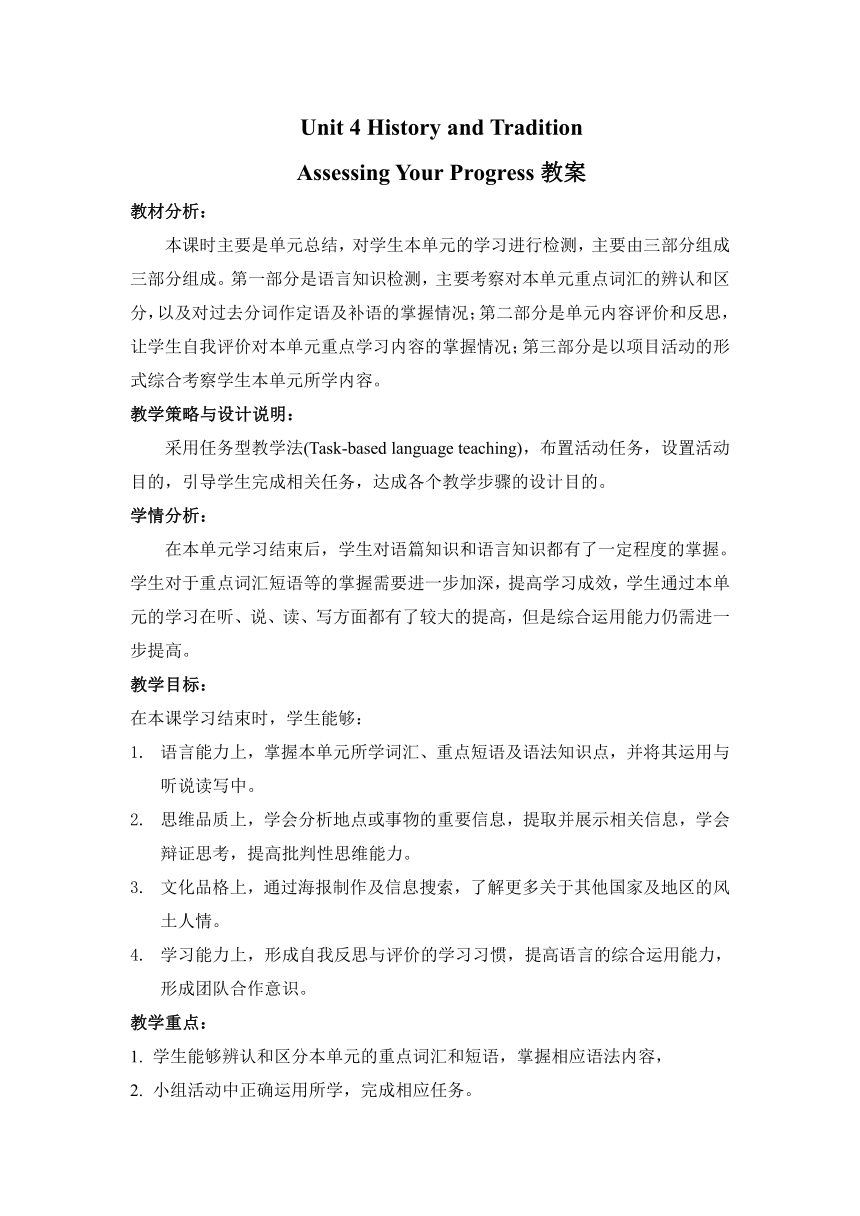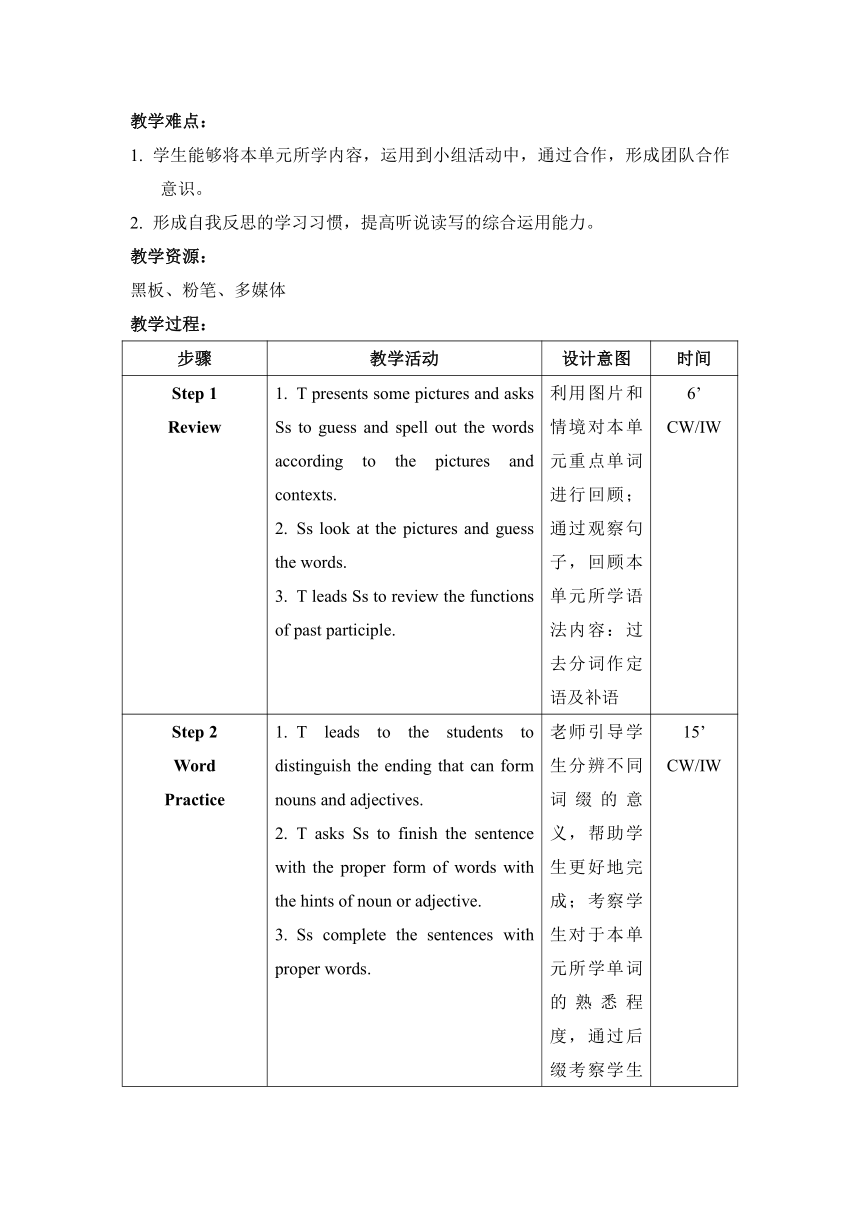人教版(2019)必修第二册Unit 4 History and Tradition Assessing Your Progress教案(表格式)
文档属性
| 名称 | 人教版(2019)必修第二册Unit 4 History and Tradition Assessing Your Progress教案(表格式) |  | |
| 格式 | docx | ||
| 文件大小 | 17.8KB | ||
| 资源类型 | 教案 | ||
| 版本资源 | 人教版(2019) | ||
| 科目 | 英语 | ||
| 更新时间 | 2024-04-02 09:51:16 | ||
图片预览


文档简介
Unit 4 History and Tradition
Assessing Your Progress教案
教材分析:
本课时主要是单元总结,对学生本单元的学习进行检测,主要由三部分组成三部分组成。第一部分是语言知识检测,主要考察对本单元重点词汇的辨认和区分,以及对过去分词作定语及补语的掌握情况;第二部分是单元内容评价和反思,让学生自我评价对本单元重点学习内容的掌握情况;第三部分是以项目活动的形式综合考察学生本单元所学内容。
教学策略与设计说明:
采用任务型教学法(Task-based language teaching),布置活动任务,设置活动目的,引导学生完成相关任务,达成各个教学步骤的设计目的。
学情分析:
在本单元学习结束后,学生对语篇知识和语言知识都有了一定程度的掌握。学生对于重点词汇短语等的掌握需要进一步加深,提高学习成效,学生通过本单元的学习在听、说、读、写方面都有了较大的提高,但是综合运用能力仍需进一步提高。
教学目标:
在本课学习结束时,学生能够:
语言能力上,掌握本单元所学词汇、重点短语及语法知识点,并将其运用与听说读写中。
思维品质上,学会分析地点或事物的重要信息,提取并展示相关信息,学会辩证思考,提高批判性思维能力。
文化品格上,通过海报制作及信息搜索,了解更多关于其他国家及地区的风土人情。
学习能力上,形成自我反思与评价的学习习惯,提高语言的综合运用能力,形成团队合作意识。
教学重点:
学生能够辨认和区分本单元的重点词汇和短语,掌握相应语法内容,
小组活动中正确运用所学,完成相应任务。
教学难点:
学生能够将本单元所学内容,运用到小组活动中,通过合作,形成团队合作意识。
形成自我反思的学习习惯,提高听说读写的综合运用能力。
教学资源:
黑板、粉笔、多媒体
教学过程:
步骤 教学活动 设计意图 时间
Step 1 Review T presents some pictures and asks Ss to guess and spell out the words according to the pictures and contexts. Ss look at the pictures and guess the words. T leads Ss to review the functions of past participle. 利用图片和情境对本单元重点单词进行回顾;通过观察句子,回顾本单元所学语法内容:过去分词作定语及补语 6’ CW/IW
Step 2 Word Practice T leads to the students to distinguish the ending that can form nouns and adjectives. T asks Ss to finish the sentence with the proper form of words with the hints of noun or adjective. Ss complete the sentences with proper words. 老师引导学生分辨不同词缀的意义,帮助学生更好地完成;考察学生对于本单元所学单词的熟悉程度,通过后缀考察学生对单词的相关派生词的了解程度。 15’ CW/IW
Step 3 Sentence Practice T asks Ss to combine the sentences into one with the past participle of verb in the second sentence. Ss think about and finish the task. 考察学生对于过去分词作定语及补语的了解程度,通过合并句子,让学生在实际运用中进行回顾。 6’ IW
Step 4 Reflecting T asks Ss to think about some questions, such as “Do you think the idioms you learnt are useful to know Why or why not” “Why is describing different sense useful when you write a text” T displays some ideas to lead Ss reflect what they have learned and how they have learned. 通过问题,学生自我回顾、反思本单元的掌握情况,有助于学生形成课后自我反思的良好学习习惯。 6’ CW
Step 5 Project Ss look at the poster and think about what information they can get from the post. It can make them to understand the contents need to be contained. Then T divides Ss into several groups and explains what words they need to do. Each group have a clear division of work, such as researching traditions, providing photos and detailed description, and T provides some suggestions for the researching of information. Ss work in groups and choose a country/city/village to introduce. Before presentation, T leads Ss to ask some question based on the Mexican post, and helps them think about what questions they can ask. Each group make their post and share their poster as well as their ideas with the class and then answer the questions raised by their classmates. T highlights how to make a good presentation, not just good delivery they use but also body language and attractive speech. Ss give a record of scores for the groups with the evaluation sheet and suggestions to the groups that show their work to help them make better poster and pick up the best group in the class. 展示课本海报, 通过学生的实际讨论让学生感知海报所需涵盖的内容,通过分析海报的优缺点,利于学生更好地制作自己的小组海报,同时培养学生的批判性思维;通过小组讨论,选择合适的主题地点;小组内分工合作完成海报制作,形成分工合作意识,为小组提出建议,营造探究学习氛围;学生在课堂展示作品,表达创作意图,锻炼其表达能力和心理素质,提高学而思的综合实践能力。 20’ GW
Step 6 Homework Design a poster for your hometown. Make sure the key information is included. 加强家乡宣传,复习新知 1’ IW
备注:T: Teacher Ss: Students
IW: Individual work GW: Group work CW: Class work
教学反思:
学生通过本课时学习,能否熟练掌握本单元各个课时中的重点词汇、短语及句型,并准确应用。
学生通过本课时学习,能否精准提取信息,完成小组分工合作,完成相应的任务。
Assessing Your Progress教案
教材分析:
本课时主要是单元总结,对学生本单元的学习进行检测,主要由三部分组成三部分组成。第一部分是语言知识检测,主要考察对本单元重点词汇的辨认和区分,以及对过去分词作定语及补语的掌握情况;第二部分是单元内容评价和反思,让学生自我评价对本单元重点学习内容的掌握情况;第三部分是以项目活动的形式综合考察学生本单元所学内容。
教学策略与设计说明:
采用任务型教学法(Task-based language teaching),布置活动任务,设置活动目的,引导学生完成相关任务,达成各个教学步骤的设计目的。
学情分析:
在本单元学习结束后,学生对语篇知识和语言知识都有了一定程度的掌握。学生对于重点词汇短语等的掌握需要进一步加深,提高学习成效,学生通过本单元的学习在听、说、读、写方面都有了较大的提高,但是综合运用能力仍需进一步提高。
教学目标:
在本课学习结束时,学生能够:
语言能力上,掌握本单元所学词汇、重点短语及语法知识点,并将其运用与听说读写中。
思维品质上,学会分析地点或事物的重要信息,提取并展示相关信息,学会辩证思考,提高批判性思维能力。
文化品格上,通过海报制作及信息搜索,了解更多关于其他国家及地区的风土人情。
学习能力上,形成自我反思与评价的学习习惯,提高语言的综合运用能力,形成团队合作意识。
教学重点:
学生能够辨认和区分本单元的重点词汇和短语,掌握相应语法内容,
小组活动中正确运用所学,完成相应任务。
教学难点:
学生能够将本单元所学内容,运用到小组活动中,通过合作,形成团队合作意识。
形成自我反思的学习习惯,提高听说读写的综合运用能力。
教学资源:
黑板、粉笔、多媒体
教学过程:
步骤 教学活动 设计意图 时间
Step 1 Review T presents some pictures and asks Ss to guess and spell out the words according to the pictures and contexts. Ss look at the pictures and guess the words. T leads Ss to review the functions of past participle. 利用图片和情境对本单元重点单词进行回顾;通过观察句子,回顾本单元所学语法内容:过去分词作定语及补语 6’ CW/IW
Step 2 Word Practice T leads to the students to distinguish the ending that can form nouns and adjectives. T asks Ss to finish the sentence with the proper form of words with the hints of noun or adjective. Ss complete the sentences with proper words. 老师引导学生分辨不同词缀的意义,帮助学生更好地完成;考察学生对于本单元所学单词的熟悉程度,通过后缀考察学生对单词的相关派生词的了解程度。 15’ CW/IW
Step 3 Sentence Practice T asks Ss to combine the sentences into one with the past participle of verb in the second sentence. Ss think about and finish the task. 考察学生对于过去分词作定语及补语的了解程度,通过合并句子,让学生在实际运用中进行回顾。 6’ IW
Step 4 Reflecting T asks Ss to think about some questions, such as “Do you think the idioms you learnt are useful to know Why or why not” “Why is describing different sense useful when you write a text” T displays some ideas to lead Ss reflect what they have learned and how they have learned. 通过问题,学生自我回顾、反思本单元的掌握情况,有助于学生形成课后自我反思的良好学习习惯。 6’ CW
Step 5 Project Ss look at the poster and think about what information they can get from the post. It can make them to understand the contents need to be contained. Then T divides Ss into several groups and explains what words they need to do. Each group have a clear division of work, such as researching traditions, providing photos and detailed description, and T provides some suggestions for the researching of information. Ss work in groups and choose a country/city/village to introduce. Before presentation, T leads Ss to ask some question based on the Mexican post, and helps them think about what questions they can ask. Each group make their post and share their poster as well as their ideas with the class and then answer the questions raised by their classmates. T highlights how to make a good presentation, not just good delivery they use but also body language and attractive speech. Ss give a record of scores for the groups with the evaluation sheet and suggestions to the groups that show their work to help them make better poster and pick up the best group in the class. 展示课本海报, 通过学生的实际讨论让学生感知海报所需涵盖的内容,通过分析海报的优缺点,利于学生更好地制作自己的小组海报,同时培养学生的批判性思维;通过小组讨论,选择合适的主题地点;小组内分工合作完成海报制作,形成分工合作意识,为小组提出建议,营造探究学习氛围;学生在课堂展示作品,表达创作意图,锻炼其表达能力和心理素质,提高学而思的综合实践能力。 20’ GW
Step 6 Homework Design a poster for your hometown. Make sure the key information is included. 加强家乡宣传,复习新知 1’ IW
备注:T: Teacher Ss: Students
IW: Individual work GW: Group work CW: Class work
教学反思:
学生通过本课时学习,能否熟练掌握本单元各个课时中的重点词汇、短语及句型,并准确应用。
学生通过本课时学习,能否精准提取信息,完成小组分工合作,完成相应的任务。
